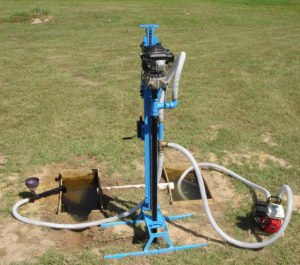Understanding the drilling method used by Lone Star Drills
Creating a safe, usable well requires a strong, efficient drill. While a variety of drilling methods exist such as air rotary drilling, cable tool drilling and more, Lone Star Drills rigs use mud rotary drilling. Mud rotary drilling is a fluid-based recirculatory method that offers support for the borehole throughout the drilling process. If you’re new to water well drilling, don’t worry! Lone Star Drills is here to help you understand the process.
How Does Mud Rotary Drilling Work?
Every mud rotary drilling project starts with two pits called the suction pit and the settling pit. The drilling crew mixes bentonite or polymer into the water until it reaches the right viscosity. The crew then pours the mixture, called “mud” or “drilling mud,” into the pits. They may need to make several barrels of drilling mud to initially fill the pits.
A drill rig rotates a bit and raises or lowers the drill pipe while a mud pump circulates the drilling mud. The mud pump pulls drilling mud from the suction pit and pumps it through the three-way valve, swivel and drill pipe to the bit. The mud travels up the borehole, removing the cuttings and carrying them into the settling pit to maintain a clean borehole for efficient drilling to continue.

While circulating, drilling mud stabilizes the borehole by forming a protective film on the interior. This keeps the borehole from collapsing until the casing is applied. Throughout this process, the remaining mud recirculates through the drill bit into the borehole to remove cuttings until drilling is completed.
Mud Rotary Drill Options
Lone Star Drills offers multiple mud rotary drills. The first option is the mechanical water well drill line. Mechanical water well drills are smaller drilling rigs that are perfect for sand, silt, clay and other thinner soil options. These drills can drill a six-inch borehole to a depth of 100-200 feet.
If you’re looking for more strength in your drill, the Lone Star hydraulic series might be best. This series offers two configurations, both including additional power options. The hydraulic drills expand on the power and drilling depths of the mechanical drills while continuing to promote versatility and portability. The more powerful hydraulic drills feature a heavy-duty swivel and anchor for pushing through rugged rock formations.
And, if that’s not enough for the size of your project, Lone Star Drills also offers a trailer-mounted water well drilling series. The trailer-mounted line balances convenience, performance and portability. These drills can bore through rocky soil conditions and don’t require heavy equipment to move. A trailer-mounted hydraulic drill can be transported by a UTV, ATV, standard pickup truck or another all-terrain vehicle.
When it comes to harder rock formations, Lone Star Drills offers a down-the-hole (DTH) hammer as an addition to the hydraulic water well drills. The DTH hammer is available in two-, three-, four- and five-inch diameters and can break through harder ground layers. The DTH hammer uses a percussive process that, while different from mud rotary drilling, can be paired with it to break through hard rock and bedrock formations.
Where Will You Drill Next?
Mud rotary drilling can be used for local, regional and even international water well drilling projects. No matter where you’re drilling next, Lone Star Drills offers unbeatable customization and portability. Both mechanical and hydraulic water well drills can be broken down for easy transportation and can be crated for shipping. Lone Star Drills works with several forwarding agents to arrange for shipping to whatever country you’re working in. This is also true for all attachments and accessories.
The Lone Star Drills team can recommend the best drill for your operation. Contact us today so we can help understand your needs and recommend the best mud rotary drill rig for your project.